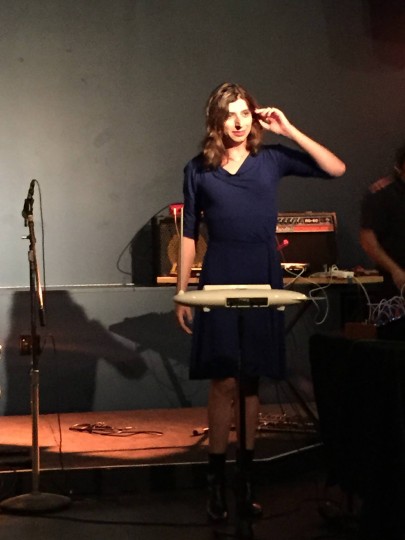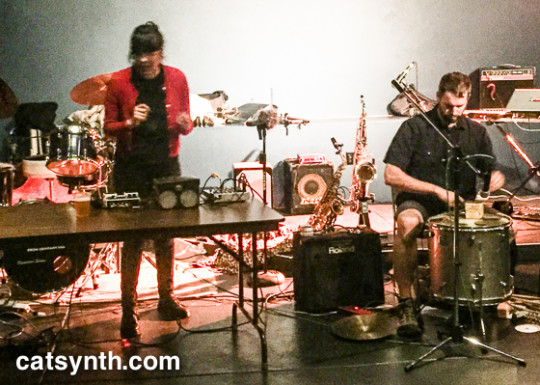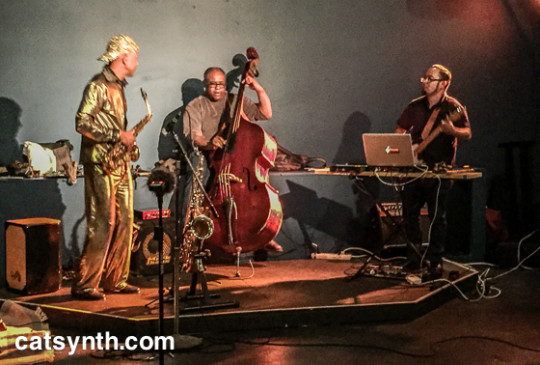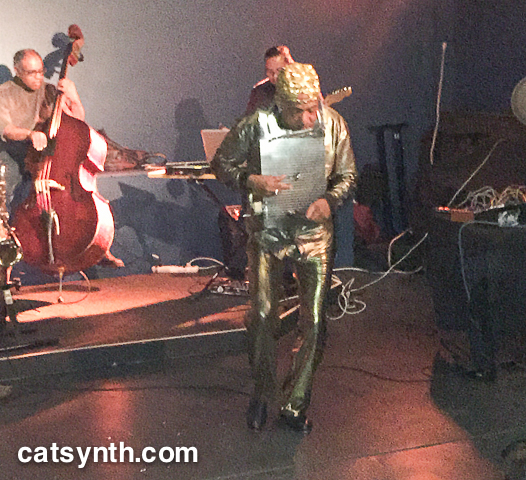While the first night of the 2015 Outsound New Music Summit was billed as “Quiet Noise”, the second night was something altogether different. The concert features three exuberant but very different bands spanning a wide variety of musical techniques and styles.
First up was Cabbages, Captain and King, a trio featuring Eli Wallace on piano, Karl Evangelista on guitar, and Jon Arkin on drums.

[Cabbages, Captain and King. Photo: peterbkaars.com.]
I have become quite a fan of Eli Wallace’s piano playing, which is virtuosic and energetic. Combined with Evangelista’s intense and varied guitar performance and Arkin’s drums, the trio packed quite a punch. The speed and energy rarely let up throughout the 45-minute set. The music had an unsettled quality, always moving forward and never quite reaching a groove or tonal center. There were occasional quiet moments when the overall intensity of the performance let up, and the final notes with prepared piano were a nice touch.

[Eli Wallace. Photo: peterbkaars.com.]
Next up was Liza Mezzacapa’s Bait & Switch performing her project avantNoir. The pieces in this project were all inspired by noir fiction. The first half was based on “hard-boiled” stories by Dashiell Hammett set in 1920s San Francisco – with many familiar places and streets references – and the second half was based on “soft boiled” stories by Paul Auster set in 1980s New York (also a familiar setting).

[Lisa Mezzacappa’s avantNOIR with Bait & Switch. Photo: peterbkaars.com.]
The music fit into the punctuated jazz style I have heard many times from Mezzacapa and her bands. But there was a distinctly 1970s crime show vibe to many of the pieces that contrasted with the times and places of the original stories’ settings. The interplay of bass, guitar with wah wah and drums, along with some of the electronic sounds from guest performer Tim Perkis led to this 1970s feel. The project itself suggests film scores for the stories, and I liked the idea of changing listeners’ expectations, especially if they have seen Hollywood versions of these stories. In addition to Mezzacapa and Perkis, the set featured Aaron Bennett on tenor saxophone, Jordon Glenn on drums, John Finkbeiner on guitar and special guest William Winant on vibraphone and sound-effects percussion. I found Winant’s seltzer bottle and tiny door particularly amusing.

[Aaron Bennett and William Winant. Photo: peterbkaars.com.]
Then it was time for Vacuum Tree Head to take the stage.

[Vacuum Tree Head. Photo: peterbkaars.com.]
Led by Jason Berry who was conducting this evening, led us through fast-paced set of short pieces that ranged from classic jazz to deep funk to something approaching metal rock. Above the fray were vocals by Amy X Neuburg, who brought her theatrical and operatic voicings to the rather challenging music along with her very distinctive performance personality.


[Amy X Neuburg and Jason Berry. Photos: peterbkaars.com.]
Many of the pieces, which were composed primarily by Berry and Michael de La Cuesta who together formed the band in 1989(!), were premiers. The band made the most of the variety of music, with an extended fusion keyboard solo by Amanda Chaudhary in DL DS, deep funk from the whole band behind Rich Corney’s guitar in EMS, a blindingly short jazz tune inspired by the Akhnaton dynasty of ancient Egypt, and a loud metal tune that may have been a first for an Outsound New Music Summit.

[Amanda Chaudhary et al. Photo: peterbkaars.com.]
Rich Lesnick (also a band-mate of mine in Reconnaissance Fly) brought solid saxophone and bass clarinet, including an extended moody bass-clarinet solo in Cushion Fortress; and Michael de la Cuesta featured in many songs on analog synthesizer, guitar and glockenspiel. Justin Markovits held things together with his drumming, assisted in the rhythm section by Tom Ferguson on bass. There was even a bit of abstract electronics from Amy X Neuburg on Blippo Box and Amanda Chaudhary on modular synth.


[Michael de la Cuesta and Justin Markovits. Photo: peterbkaars.com.]
The set was very well received by audience, some of whom were longtime fans of the band and some hearing us for the first time. And personally, it was quite a privilege to be part of the band for this event.
Overall, it was a strong evening for the summit, one that stood out as quite contrasting among the sets as well as with the other concerts.






























